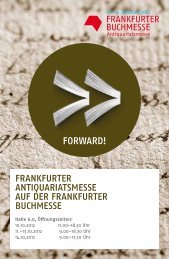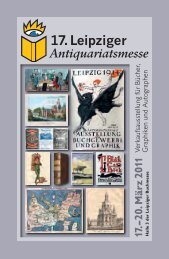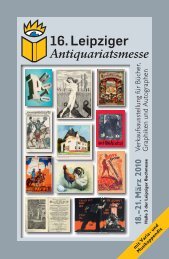18. Leipziger - abooks
18. Leipziger - abooks
18. Leipziger - abooks
Sie wollen auch ein ePaper? Erhöhen Sie die Reichweite Ihrer Titel.
YUMPU macht aus Druck-PDFs automatisch weboptimierte ePaper, die Google liebt.
Antiquariat Michael Kühn<br />
ground developed Guarini’s magnum opus on geometry, the Euclides Adauctus et methodicus mathematicaque universalis<br />
published in 1671. Guarini, therefore, falls well within the tradition of Euclidean commentators. His interest<br />
for the discipline went beyond the mere content, however, as Euclidean geometry was for him a sort of universal key for<br />
human knowledge. The extent to which Guarini considered Euclidean norms as the basis of every scientific work is also<br />
clear from another work of his, the Trattato di Fortificazione, where the Euclidean basic definitions of point, line, etc.<br />
are provided at the very beginning as a kind of conditional entry to the topic. The same approach occurs with his Del<br />
modo di Misurare le fabbriche, a booklet on mensuration.- Cicognara 524; Riccardi I, 636; STC, XVII sec. I, 423. DBI<br />
LX, 369-378; Cat. Vinciana 1574; Macclesfield 950; Thieme-Becker XV, 174 ff.; Turner [ed.] Dict. Art XIII, 748 ff.;<br />
Enc.Arch. 265-279; E.C. Robinson. Optics and mathematics in the domes churches of G.G.; in: Journal of the Society of<br />
Architectural Historians L (1991), 384 – 401; A. Mastrorilli. Scienza e meccanica in G. G. in: Quaderni dell’Istituto di<br />
storia dell’architettura I (1998), 47-68; Michele Sbacchi. Euclidism and Theory of Architecture.<br />
– Mathematisches Instrument –<br />
Lupicini, Antonio. Discorso sopra la fabbrica delle nuove verghe astronomiche. Fiorenza:<br />
appresso Giorgio Marescotti, 1582. 4° [205 x 150 mm]. 53 pp., [1]. With woodcut printer’s<br />
mark on title and on last page, and 15 woodcuts (7 full-page). XVIII century half-vellum (recased,<br />
new end-papers). Title fingermarked and with a library accession number, minuscule hole on<br />
pages 7-8 not affecting printed surface, little foxing in places, otherwise a good copy. 2.400,-<br />
Only edition with nice woodcuts of the instrument. Antonio Lupicini was a prominent military architect, hydraulic<br />
engineer and astronomer born in Florence, who participated to the war of Florence against Siena in 1552. In 1578<br />
he was sent to the Emperor Rudolf II by his employer, the Grand-Duke of Tuscany, in order to improve the fortifications<br />
of Vienna against the Turks, in 1584 he worked in Venice to secure protection of the lagoon against seaborne<br />
attacks and later on, in 1589, he was active in the chaneling of the Arno in Florence and the drainage of Maremma<br />
marshes. He published in the same year and by the same publisher an esteemed manual of military architecture.<br />
This book is a richly illustrated manual for an instrument invented by the same Lupicini, consisting essentially of<br />
an improved Galilean compass. Its design is very similar to the instrument of Jobst Bürgi, whose description was<br />
published in 1603 by Hulsius. Its applications to several problems, especially in ballistics and fortification as<br />
expected, but also in surveying and cartography, are discussed.Riccardi I/2, 59; Adams L-1723; 1499; Houzeau-<br />
Lancaster 2741; Boffito (Gli strumenti della scienza) 91; not in Cockle, Daumas and Kiely.<br />
– Proclus über Bewegung –<br />
Valdagni, Giuseppe. Iosephi Valdanii medici Veronensis de mistione dialogi duo... Item<br />
[P]rocli de motu libri duo ab eodem conuersi. Basileae [Basel]: Petrum Pernam, 1562. 8° [155<br />
x 95 mm]. [8], 173 pp., [1, blank] Later halfvellum, titlepage restored in margins, with loss of a<br />
single word [P] in Procli. Else good, with geometrical woodcut diagrams within text. 1.600,-<br />
First edition, thus. A book on the greek stoic philosopher Chrysippus’ of Soli process of dissolution [Mischungslehre]:<br />
the elements change into one another by a process of condensation and rarefaction. Based on works by Johannes Baptista<br />
Montanus (1498-1551), one of the leading humanist physicians of Italy, a friend of the pioneering anatomist Andreas Vesalius.<br />
Montanus promoted the revival of greek medical texts and practice. Included in this volume is the latin translation<br />
of “Stoicheiosis physike he peri kineseos” [Institutio Physica, or Elements of Physics] of Proclus, a compendium of the<br />
last five books of Aristotle’s De physica auscultatione. It consists of propositions and their proofs, after the model of<br />
Euclid, and deals with motion along aristotelian lines. The first book begins with definitions of the continuous, of entities<br />
touching and following each other, of the first time and place, and of rest. The propositions or theorems following these<br />
definitions consider the properties of the indivisible and the divisible, particularly with respect to motion, infinity,<br />
divisibility of time and magnitudeand motion and their mutual relations. From the 12th cent. latin translations of the text<br />
circulated [seven manuscripts known], but the greek text was first published in Basel, 1531 by Simon Grynaeus, followed<br />
by a latin edition of Martinus Cuneatis in 1542 [Paris] and a greek/ latin edition of Justus Velsius (approx. 1510-1581)<br />
1545 by Herwagen [Basel]. A french translation was made by Forcadel in 1565. Ficino states thathe made a new translation<br />
of the work, but his translation is lost. The sixteenth century saw three new translations, one of them by Francesco Patrizi.<br />
About Giuseppe Valdagni ist not much known, a medicin in Verona in the 16th cent., who has written a book on theriacs<br />
and on comets: Riposte ad alcune appositioni fatte contra il discorso [Hellmann 430jk] [Pizzamiglio. L’astrologia in italia<br />
in all’ epoca di Galilei 79]. He might have been lecturing in Brixen.- not in Hoffmann III, 289; not in Hirsch, Honeyman,<br />
et al. Bietenholz, Ital. Humanismus 135; Dimitri Nikulin. Physica more geometrico demonstrata: Natural Philosophy in<br />
Proclus; in: Cleary/ Gurtler. Proceedings of the Boston Area Colloquium in Ancient Phil. pp. 163 ff.<br />
Scherffer, Carl. Abhandlung über die geographische und orthographische Projektion<br />
einer bey dem Pole zusammen gedrückten Elliptoide, wie auch über die Figur des Erdschattens<br />
bey Mondfinsternissen. Wien: gedruckt bey Johann Thomas Trattnern, 1778.<br />
8°. 93 pp., [3] with six fold. plates Blue plain later paperboards, fresh. 800,-<br />
Early work on map projection by the learned Jesuit Karl Scherffer. Der Jesuit Karl Scherffer (1716-1783) war von<br />
1748-1750 Lehrer der Mathematik in Graz und zuletzt auch Aufseher der Sternwarte daselbst, dann Mitglied der<br />
philosophischen Fakultät der Universität zu Wien und 1751 öffentlicher Lehrer der Anfangsgründe der Mathematik<br />
und Physik an derselben, später, nach Aufhebung des Ordens ordentlicher Professor der höheren Mathematik an<br />
dieser Universität.- De Backer/S. VII, 771,27; Pogg. II, 791; Wurzbach XXIX,216; Giese 1608. KVK: Stabi Berlin,<br />
Halle, Göttingen, Munich; COPAC: UCL [Graves copy], BL London; OCLC: only New York Public.<br />
89









